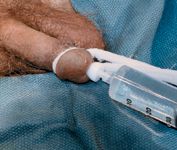Article
Posterior urethral injuries: How to evaluate and manage
When men sustain pelvic fracture trauma, an associated posterior urethral injury will occur 4% to 10% of the time. This article discusses the evaluation and diagnosis of urethral injuries and outlines our group's approach to urethral reconstruction.
When men sustain pelvic fracture trauma, an associated posterior urethral injury will occur 4% to 10% of the time. This article discusses the evaluation and diagnosis of urethral injuries and outlines our group's approach to urethral reconstruction.
Evaluation/diagnosis


Treatment options
Management options after acute trauma include SP tube placement with delayed reconstruction and early posterior realignment. While the ideal treatment choice is controversial, both options are considered reasonable.
The advantage of posterior urethral realignment with catheter placement is that open reconstruction is avoided if the procedure is successful. One disadvantage of this technique is that when it is not successful, reconstruction is delayed. When patients are treated with realignment, an endoscopic management mindset often develops. Recurrent strictures highly amenable to definitive repair are instead managed with multiple endoscopic procedures: self or office dilations and/or incisions. When a stricture develops after urethral catheter removal, the appropriate management is SP urinary diversion and delayed definitive urethral reconstruction.
In general, it is reasonable to proceed with open posterior repair 3 months after the initial injury. In patients who develop recurrent strictures after realignment and/or failed endoscopic procedures, reconstruction should proceed 3 months after urethral catheter removal. It is not necessary to wait longer from a urologic standpoint; however, patients who sustain severe pelvic and lower extremity orthopedic injuries may require prolonged rehabilitation.
Reconstructing the urethra
Urethral reconstruction is performed in the exaggerated lithotomy position. When patients do not tolerate this position in the office setting, orthopedic consultation is indicated to determine when the patient will be a candidate for prolonged lithotomy positioning from an orthopedic standpoint.
Prior to surgical repair of the urethra, imaging is performed to assess the length and location of the injury, which is almost always an obliterative distraction of the membranous urethra, but which also can involve the bulbar urethra or the posterior urethra proximal to the membranous urethra.






